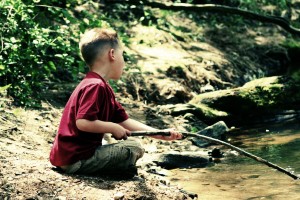 How much time did you spend outside as a child? Do you remember spending hours cloud gazing, eagerly turning over rocks in search of bugs, happily chasing butterflies, extracting the sweet nectar from honeysuckles, or exploring the far edges of your back yard? Will your children have similar memories?
How much time did you spend outside as a child? Do you remember spending hours cloud gazing, eagerly turning over rocks in search of bugs, happily chasing butterflies, extracting the sweet nectar from honeysuckles, or exploring the far edges of your back yard? Will your children have similar memories?
According to a report that was released in 2009 by the Environmental Protection Agency, Americans, including children, now spend more than 90% of their time indoors. An increase in addictive electronic entertainment, smaller and less accessible green spaces, and restricted outdoor play have all combined to result in a generation that is largely out-of-touch with and disconnected from the natural world. Robert Louv, author of the best selling book Last Child in The Woods, coined a term for this phenomenon: Nature Deficit Disorder. Louv observed that when a child or teenager does not have adequate unstructured time surrounded by nature, they often display several symptoms of ADHD.
Dutch researchers conducted a study, published in the Journal of Epidemiology and Community Health. that found that individuals who live within 0.6 miles of green space (such as a forest or park) experience lower levels of anxiety and depression. A study in 2001 found that children with ADHD demonstrated a reduction in symptoms after spending time participating in activities that took place in a natural setting (such as playing in the woods or fishing). A 2005 study revealed that taking long countryside walks on a weekly basis improved self esteem in participants and provided mood-elevating results that were similar to the effects of anti-depressants.
In addition to lower levels of anxiety and depression, regular exposure to nature has also been tied to increased impulse control and enhanced cognitive functioning. A child’s brain needs to work overtime to keep up with the constant stimuli that comes with living in an modern urban environment. Time in nature, away from everything but the peaceful sounds of wildlife and natural elements, can provide an opportunity for the mind and body to relax and to recharge. Experts recommend providing children with a “green hour” every day. This should be unstructured time for a child to explore and interact with the natural world.





